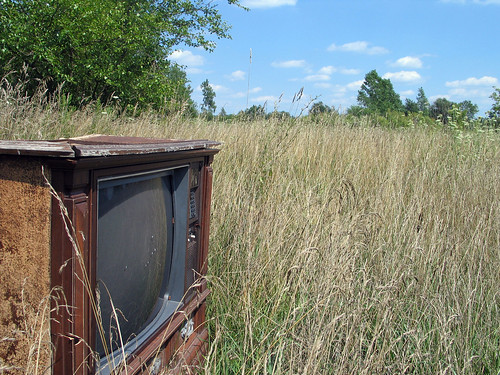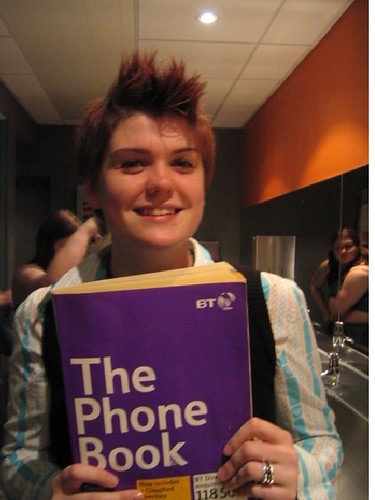Video can be more than VHS tapes
I'm 29. But I've been producing, shooting and editing video for a long time.
17 years to be exact. Back then it was Super VHS, 3/4 inch or Beta. Editing was tape to tape (still is for most local daily news) - "linear" it's called. The only computer I used was a Video Toaster- a piece of crapiness put out by Amiga that really did nothing to change the mechanics of the process.

When I hear people speculating about whether online video will ever be what television is, I think about the tools I first used to make video. I remember taking apart a vcr with the tape inside it to watch how it worked.

I think about that time because that's exactly where we are with online video. Linear.
Think about your wmv, quicktime file or even your flash movie. The progress bar is a straight line. You can go forward, you can go back, but that's it. It's an unbreakable block of information that can only be decifered one way.
 Digital video isn't linear, it's spacial, just like text or code.
Digital video isn't linear, it's spacial, just like text or code.
If I read an article or a post, I can do anything I want to it. I can highlight any snippet I want and copy it to my own publishing space. I can aggregate headlines, or text or keywords into any form I want.
That's exactly how my NLE works (Non-linear editing system - I use Final Cut Pro). I load up my video onto hard drives, the video is tagged temporally with time code, and I can instantly grab any piece of any file I upload, copy it and republish it in whatever mutated form I want in a new linear form.
Part of what the internet does so well is break up what is very big into little flexible chunks so you can cater them to your specific needs. As the uses for those chunks become clear, you can automate the process so the aggregation and search tools begin to predict your needs before you experience them.
Video data can be that kind of content. The way we comprehend visual and auditory information and entertainment can fundamentally change from linear and fixed to dynamic and spacial.
Admittedly, there are some structural differences between the video I put in my NLE and the video you watch online that are barriers to what I'm describing (I won't bore you with them, but if you want to appear video savvy, you can refer to your online video as long GOP technology). But it won't be hard to overcome them.
I think it will happen soon enough. Motionbox is already taking a big step forward - their player allows you to easily highlight any segment of a video clip and forward just that segment on to others or embed it on your own site.

In my mind, wondering if internet video can ever be like TV is kind of like wondering if Google can ever be like the Phone Book.
17 years to be exact. Back then it was Super VHS, 3/4 inch or Beta. Editing was tape to tape (still is for most local daily news) - "linear" it's called. The only computer I used was a Video Toaster- a piece of crapiness put out by Amiga that really did nothing to change the mechanics of the process.

When I hear people speculating about whether online video will ever be what television is, I think about the tools I first used to make video. I remember taking apart a vcr with the tape inside it to watch how it worked.

I think about that time because that's exactly where we are with online video. Linear.
Think about your wmv, quicktime file or even your flash movie. The progress bar is a straight line. You can go forward, you can go back, but that's it. It's an unbreakable block of information that can only be decifered one way.
 Digital video isn't linear, it's spacial, just like text or code.
Digital video isn't linear, it's spacial, just like text or code. If I read an article or a post, I can do anything I want to it. I can highlight any snippet I want and copy it to my own publishing space. I can aggregate headlines, or text or keywords into any form I want.
That's exactly how my NLE works (Non-linear editing system - I use Final Cut Pro). I load up my video onto hard drives, the video is tagged temporally with time code, and I can instantly grab any piece of any file I upload, copy it and republish it in whatever mutated form I want in a new linear form.
Part of what the internet does so well is break up what is very big into little flexible chunks so you can cater them to your specific needs. As the uses for those chunks become clear, you can automate the process so the aggregation and search tools begin to predict your needs before you experience them.
Video data can be that kind of content. The way we comprehend visual and auditory information and entertainment can fundamentally change from linear and fixed to dynamic and spacial.
Admittedly, there are some structural differences between the video I put in my NLE and the video you watch online that are barriers to what I'm describing (I won't bore you with them, but if you want to appear video savvy, you can refer to your online video as long GOP technology). But it won't be hard to overcome them.
I think it will happen soon enough. Motionbox is already taking a big step forward - their player allows you to easily highlight any segment of a video clip and forward just that segment on to others or embed it on your own site.

In my mind, wondering if internet video can ever be like TV is kind of like wondering if Google can ever be like the Phone Book.





0 Comments:
Post a Comment
<< Home